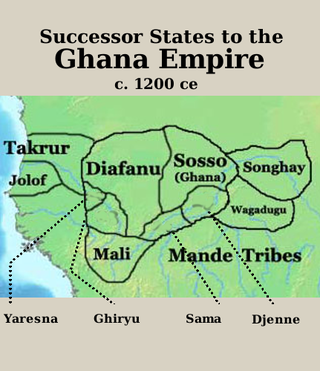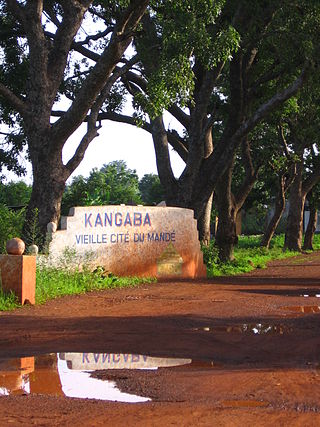
The Mali Empire was an empire in West Africa from c. 1226 to 1670. The empire was founded by Sundiata Keita and became renowned for the wealth of its rulers, especially Mansa Musa. At its peak, Mali was the largest empire in West Africa, widely influencing the culture of the region through the spread of its language, laws, and customs.

The balafon is a gourd-resonated xylophone, a type of struck idiophone. It is closely associated with the neighbouring Mandé, Bwaba Bobo, Senoufo and Gur peoples of West Africa, particularly the Guinean branch of the Mandinka ethnic group, but is now found across West Africa from Guinea, Burkina Faso, Mali. Its common name, balafon, is likely a European coinage combining its Mandinka name ߓߟߊ bala with the word ߝߐ߲ fôn 'to speak' or the Greek root phono.

A griot is a West African historian, storyteller, praise singer, poet, and/or musician.

The Mandinka or Malinke are a West African ethnic group primarily found in southern Mali, the Gambia, southern Senegal and eastern Guinea. Numbering about 11 million, they are the largest subgroup of the Mandé peoples and one of the largest ethnic-linguistic groups in Africa. They speak the Manding languages in the Mande language family, which are a lingua franca in much of West Africa. Virtually all of Mandinka people are adherent to Islam, mostly based on the Maliki jurisprudence. They are predominantly subsistence farmers and live in rural villages. Their largest urban center is Bamako, the capital of Mali.
Sundiata Keita was a prince and founder of the Mali Empire. He was also the great-uncle of the Malian ruler Mansa Musa, who is usually regarded as the wealthiest person of all time, although there are no reliable ways to accurately calculate his wealth.
The Mandé people are an ethnic and linguistic group who are native to West Africa, possessing a long shared history and forming a distinct linguistic family known as the Mandé Languages. The Mandé languages are divided into two primary groups: East Mandé and West Mandé.

Soumaoro Kanté was a 13th-century king of the Sosso people. Seizing Koumbi Saleh, the capital of the recently defunct Ghana Empire, Soumaoro Kanté proceeded to conquer several neighboring states, including the Mandinka people in what is now Mali. However, the Mandinka prince Sundiata Keita built a coalition of smaller kingdoms to oppose him at the Battle of Kirina, defeating the Sosso and leaving Sundiata's new Mali Empire dominant in the region.
Sunjata is an epic poem of the Malinke people that tells the story of the hero Sundiata Keita, the founder of the Mali Empire. The epic is an instance of oral tradition, going back to the 13th century and narrated by generations of griot poets or jeliw (djeli). There is no single or authoritative version. Material pertaining to the epic first began to be collected during the early 20th century in French Sudan, notably by the French elite school École William Ponty, resulting in the "modern" version of the tale as considered standard today, based on the oral account by Djeli Mamoudou Kouyate, a griot or traditional oral historian, translated into French by Djibril Tamsir Niane in 1960.

The Sosso Empire, also written as Soso or Susu, or alternatively Kaniaga, was kingdom of West Africa that originated as a vassal of the Ghana Empire before breaking away and conquering their former overlords. Inhabited by the Soninke ancestors of the modern-day Sosso people, it was centered in the region south of Wagadou and north of Beledougou. The empire peaked under the reign of Soumaoro Kante, who was defeated by the rising Mali Empire of Sundiata Keita.
The Keita dynasty ruled pre-imperial and imperial Mali from the 11th century into the early 17th century. It was a Muslim dynasty, and its rulers claimed descent from Bilal Keita, despite Bilal having been of Abyssinian origin.

Djibril Tamsir Niane was a Guinean historian, playwright, and short story writer.

Siby is a village and rural commune in the Cercle of Kati in the Koulikoro Region of southern Mali. The commune contains 21 villages and in the 2009 census had a population of 26,632. The village lies 50 km southwest of the capital, Bamako, on the plain to the south of the Monts Mandingues. The RN5 road that links Bamako with Siguiri in Guinea runs through the village.
The Gbara or Great Assembly was the deliberative body of the Mali Empire, which ruled much of West Africa during the Middle Ages. It was first formed in 1235 on the orders of Sundiata in the Mandinka constitution known as the Kouroukan Fouga.
The Twelve Doors of Mali were the possessions of the Mansa (emperor) of the medieval Mali Empire which was established in c.. 1235 following The Battle of Kirina. These lands were either allied to or conquered by Sundiata Keita on his campaign to free the Mandinka heartland from the Sosso kingdom of Kaniaga.

Pre-imperial Mali refers to the period of history before the establishment of the Mali Empire, an African empire located mostly in present-day Mali, in c. 1235.
The military history of the Mali Empire is that of the armed forces of the Mali Empire, which dominated Western Africa from the mid 13th to the late 15th century. The military culture of the empire's driving force, Mandinka people, influenced many later states in West Africa including break-away powers such as the Songhay and Jolof empires. Institutions from the Mali Empire also survived in the 19th century army of Samory Ture who saw himself as the heir to Old Mali's legacy.

Kangaba is a town, commune, and seat of the Kangaba Cercle in the Koulikoro Region of south-western Mali.
Mamadou Sidiki Diabaté is a prominent Mandé kora player and jeli from Bamako, Mali. He is the 71st generation of kora players in his family and a son to Sidiki Diabaté.

Manding, Manden or even Mandé is a region located in West Africa, a space between southern Mali and eastern Guinea. It is the historic home of the Mandinka community.
Sogolon Wulen Condé of Dò ni Kiri, commonly known as Sogolon Condé, was a 13th-century princess of Imperial Mali, and one of the prominent women portrayed in the Epic of Sundiata. Her trials and tribulations are well preserved in the epic. She was the second wife of Faama (King) Naré Maghann Konaté, and mother of Mansa Sundiata Keita, founder of the Mali Empire in the 13th century. According to Bamba Suso and Banna Kanute, Sogolong's father was Sankarang Madiba Konte, also known as Faa Ganda, a descendant of Khulubu Konte. In the epic, Sogolon is portrayed as the daughter of the "buffalo woman" –so-called because of her "ugliness" and hunchback, and so was Sogolong. The griots of Guinea refer to Sogolon as the younger sister of Do Kamissa. In many parts of the Senegambia region, and Mali, Sogolon is regarded as her daughter. As well as her physical deformities and "ugliness", Sogolon also gave birth to a disabled son (Sundiata), and was ridiculed for that. Following the death of her husband Naré Maghann Konaté, her co-wife, the politically ambitious Sassouma Bereté, Naré Maghann's first wife along with their first son Dankaran Toumani Keïta, plotted against Sogolon and her children, including assassination attempts on their lives. Fearing that the new King Dankaran and his mother Sassouma could inflict harm upon her and her children, Sogolon went into exile with her children to protect them from harm. Due to the power and influence of Dankaran and his mother, Sogolon and her children were refused asylum by many states within the Ghana Empire they traversed seeking protection. She was eventually granted asylum by the King of Mema Mansa Farin Tunkara. In Mema, Sogolon encouraged his disabled son Sundiata to fulfill his destiny, and return to Mali (Manden) and take the throne.
![The door of the Kouroukan Fouga, in actual Kangaba, in Republic of Mali [?][?][?][?][?][?][?][?][?][?][?][?][?] [?][?][?][?][?][?].jpg](http://upload.wikimedia.org/wikipedia/commons/thumb/a/a8/%DF%9E%DF%99%DF%8E%DF%AC%DF%9E%DF%8A%DF%B2%DF%AC%DF%9D%DF%8E%DF%A5%DF%8A%DF%AB_%DF%98%DF%8F%DF%B2%DF%AC%DF%98%DF%8A.jpg/220px-%DF%9E%DF%99%DF%8E%DF%AC%DF%9E%DF%8A%DF%B2%DF%AC%DF%9D%DF%8E%DF%A5%DF%8A%DF%AB_%DF%98%DF%8F%DF%B2%DF%AC%DF%98%DF%8A.jpg)









